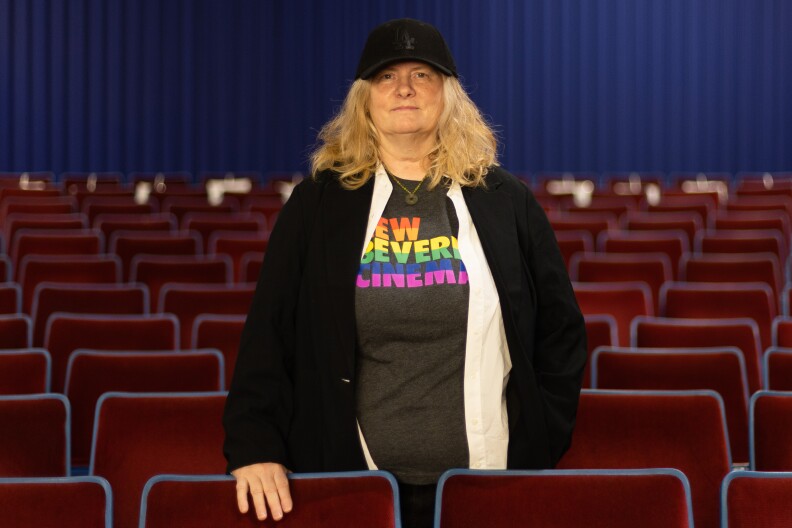The New Beverly Cinema has had many, many lives. It’s been an ice cream factory, a nightclub and a porn theater. Today it’s the home of director Quentin Tarantino’s personal film collection — a place where you can always catch a classic double feature, or a marathon of, say, all the Twilight movies, on 35mm.
“Quentin has a vast collection. Cartoons, trailers, 35 features, 16 features,” says the theater’s operations manager Jules McLean. “We have a warehouse full of film.”
The importance of film
At the New Beverly, the projection booth is where the magic happens. Everything at this revival house is always on film, which means specialty and rare prints, vivid colors and sound, and that inimitable warmth and grain that appears on screen.
(And don’t worry if you don’t know the difference between 16mm, 35mm, and 70mm. To put it simply, that’s the difference in the width of the film strip. The bigger the number, the higher quality the image.)
Revival House: The New Beverly Cinema, Always On Film
“I think there’s a tendency to think film is precious, which it is, and we should be preserving it. But I think it’s more important to be screening the prints,” says New Beverly projectionist Danielle Wakin.
Projecting film isn’t just hitting play on a movie — there’s a whole show going on up in the booth that audience members never get to see. Before the movie starts, the projectionist checks the film reel for dust and debris. They measure the reel and mark out “changeover cues” — that’s where they’ll literally load and change reels. Most feature films take up between five and nine reels.
“There’s an art to it, there’s timing … but yeah, there’s nothing better than whenever you hit every changeover and it’s a perfect show,” Wakin explains. “Or watching my coworker have a perfect show is also a very, very good feeling.”
Given the effort that goes into projecting film, this isn’t an experience you can get at any movie house (and it’s the center of a contentious debate in the moviegoing world). But it should be noted that the additional effort of a movie house and projectionist to screen a print that might be decades old, does turn a screening into something special.
With the emphasis on film — and the Tarantino connection — it’s easy to assume that The New Bev might be intimidating, or full of “film bros” ready to judge. But the programming is accessible and diverse.
“I think that is what makes the New Bev cool is [the movies] we show isn’t just, you know, like Jeanne Dielman, which like a bunch of film school people show up. But then we had like a Twilight marathon for Twilight fans,” says Wakin. “It’s like we kind of show something for everyone.”
The New Bev welcomes kids too — weekend screenings always include family matinees, where you can catch films like A Goofy Movie, The Muppet Movie, or E.T.
But one of Wakin’s favorite moments was the screening of the cult classic Phantom of the Paradise.
Phantom of the Paradise is a 70s rock musical directed by Brian De Palma with music by Paul Williams. It’s a blend of Faust, Phantom of the Opera, and a critique of the music industry, with fabulous costumes, musical numbers, and a dash of horror. While it didn’t get rave reviews upon its release, it found a dedicated fanbase, even inspiring the French duo who would become Daft Punk.
“I remember sitting there in the theater, and when Beef came on screen the whole audience roared and I was just smiling and I was like, ‘this is why I work here,’” she says.
From candy to porn to ‘respectable movies’
So, how exactly did Quentin Tarantino end up owning the New Bev?
Well, it’s kind of a long story.
The building’s been around since 1929, and in the ’30s it was occupied by a candymaker, and then an ice cream manufacturer.
“Then it became Slapsy Maxie’s Nightclub in 1937, starring the once famous Maxie Rosenblum,” says theater historian Ross Melnick.

Slapsy Maxie’s was a Mid-City nightclub that is now the home of the New Beverly Cinema.
Courtesy of the Huntington Gardens Digital Library
)
Slapsy Maxie’s was a celebrity hotspot run by actor and former boxer Maxie Rosenbloom, nicknamed “Slapsie” for how he liked to throw a punch with an open glove.
Slapsy Maxie’s moved locations and other nightclubs moved in and out of the space throughout the 1940s. In the ’50s, the space became a venue for live theater — The New Globe. The demographics of the Fairfax area were shifting and the neighborhood was starting to become primarily Jewish.
“The New Globe became a venue for actually Yiddish and other theater … it was actually in part because of the location, the Jewish community was leaving Boyle Heights and coming to Fairfax,” says Melnick. “And so this was a place where Yiddish theater could actually survive for a time.”
But by 1958, live theater was no longer drawing crowds. A film producer purchased the space and divided it into two cinemas, named the Riviera-Capri.
When the 1960s hit, almost every theater in the city had to make the decision — pivot to porn, or no?
The theater was renamed again in 1970 to “the very appropriate Eros Theater, which had not only films, but also live nude dancing,” says Melnick. “The Beverly name was inaugurated in 72, and adult films continued until about 1977.”
At the end of the 1970s, local publishers started banning ads for adult films. Business started to dip for the Bev, creating an opportunity for yet another buyer.
How Tarantino got involved
In 1978, Sherman Torgan, a location scout described by the Los Angeles Times as a 33-year-old “mild mannered UCLA graduate in sociology,” took over the theater. He’s quoted as saying he “wanted to get in a business that really had sort of a positive vibe. Movies put a smile on people’s faces.”
The Times headline ran: “Theater Returns to Respectability.”
Early double features at the now “NEW” Beverly that summer included Cabaret and Sweet Charity, and Robert Altman’s 3 Women paired with Ingmar Bergman’s Face to Face.
It was during this time that a young Quentin Tarantino started going to the movies here. It was his childhood movie house, so his love for the place started early.
When Sherman Torgan died in 2007, it was a tough time for movie theaters. DVD sales were booming and services like Netflix started streaming.
Tarantino had already been subsidizing the theater for $5,000 a month, so he decided to purchase the theater outright in 2010, and took over operations in 2014. He’s quoted as saying: “As long as I’m alive, and as long as I’m rich, the New Beverly will be there, showing double features in 35mm.”
Torgan’s son Michael continues to help operate and program the theater.

Jules McLean, director of operations, in the auditorium of the New Beverly Cinema on Monday, Feb. 12, 2024.
Jules McLean has now been running the New Beverly for 10 years. And her history with Tarantino goes back even further.
“I knew Quentin because we worked at Video Archives together. So we have a long history and friendship,” says McLean.
She worked as his personal assistant for years, saying “one of the things you do for a film director is try to facilitate his dream.” That’s the attitude she brings to the New Beverly.
“I’m facilitating Quentin’s dream, which was part of, you know, Sherman’s dream.”
Tarantino’s house, a community hub
There is a LOT of film here.
According to McLean, “probably 60, 65% of the stuff we show is Quentin’s collection.”
The New Bev often screens Tarantino’s films as midnight movies every few weeks — titles like Kill Bill, Pulp Fiction, Django Unchained — the whole filmography, really.

The projection room at the New Beverly Cinema only projects film.
McLean says even the weekday matinees sell out. It’s a relief. After the pandemic shut theaters down, there was a question about whether places like the New Bev could bounce back. But it has indeed come back, and McLean says it’s attracting new audiences.
For her, it’s all about passing on that communal moviegoing experience to the next generation.
“I cannot stress how important it is to see films with an audience. That communal feeling, you can’t replicate that,” she says. “I think you get something emotionally and even though you might not know the 200 people you’re sitting with, you just had a collective experience.”
And she’s seen those collective experiences turn into relationships: “I know so many people that have met their husband, wife, partner here, you know, friendships just because they came to the New Beverly.”
“I know it sounds antithetical because you’re just sitting passively,” adds Melnick. “But in fact, you’re connecting with the filmmaker and the actors and everyone else who put that film together. And then you’re connecting with everyone else around you.”
Whether you bring a date, make a friend or go solo and find a friend in the movies, you won’t be alone catching a movie on film at the New Bev.
Thanks for joining us at the movies. It’s all part of a new series from How to LA called Revival House. Check it out wherever you get your podcasts.
What questions do you have about Southern California?
window.fbAsyncInit = function() { FB.init({
appId : '252516806593564',
xfbml : true, version : 'v2.9' }); };
(function(d, s, id){
var js, fjs = d.getElementsByTagName(s)[0];
if (d.getElementById(id)) {return;}
js = d.createElement(s); js.id = id;
js.src = "https://connect.facebook.net/en_US/sdk.js";
fjs.parentNode.insertBefore(js, fjs);
}(document, 'script', 'facebook-jssdk'));
Source link

